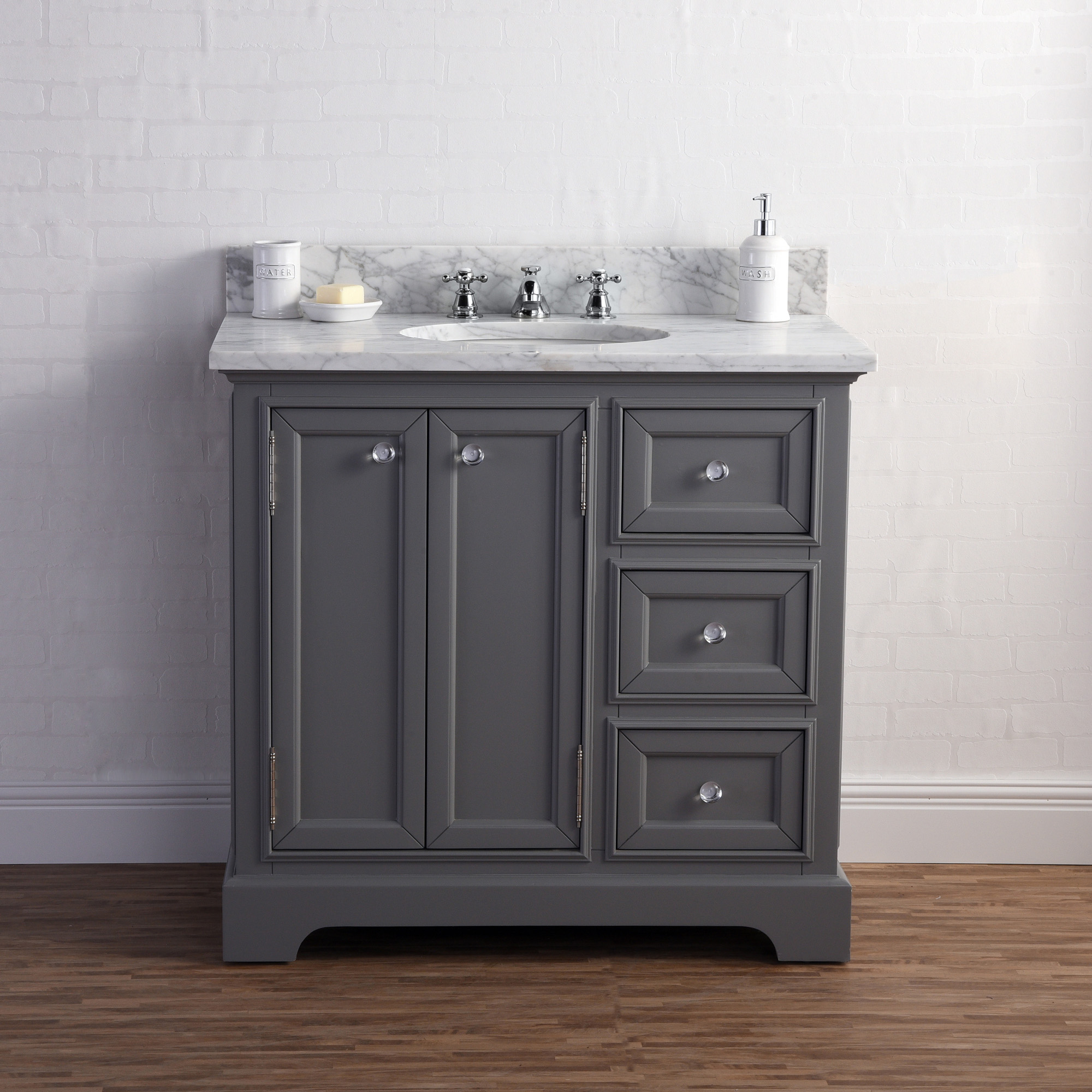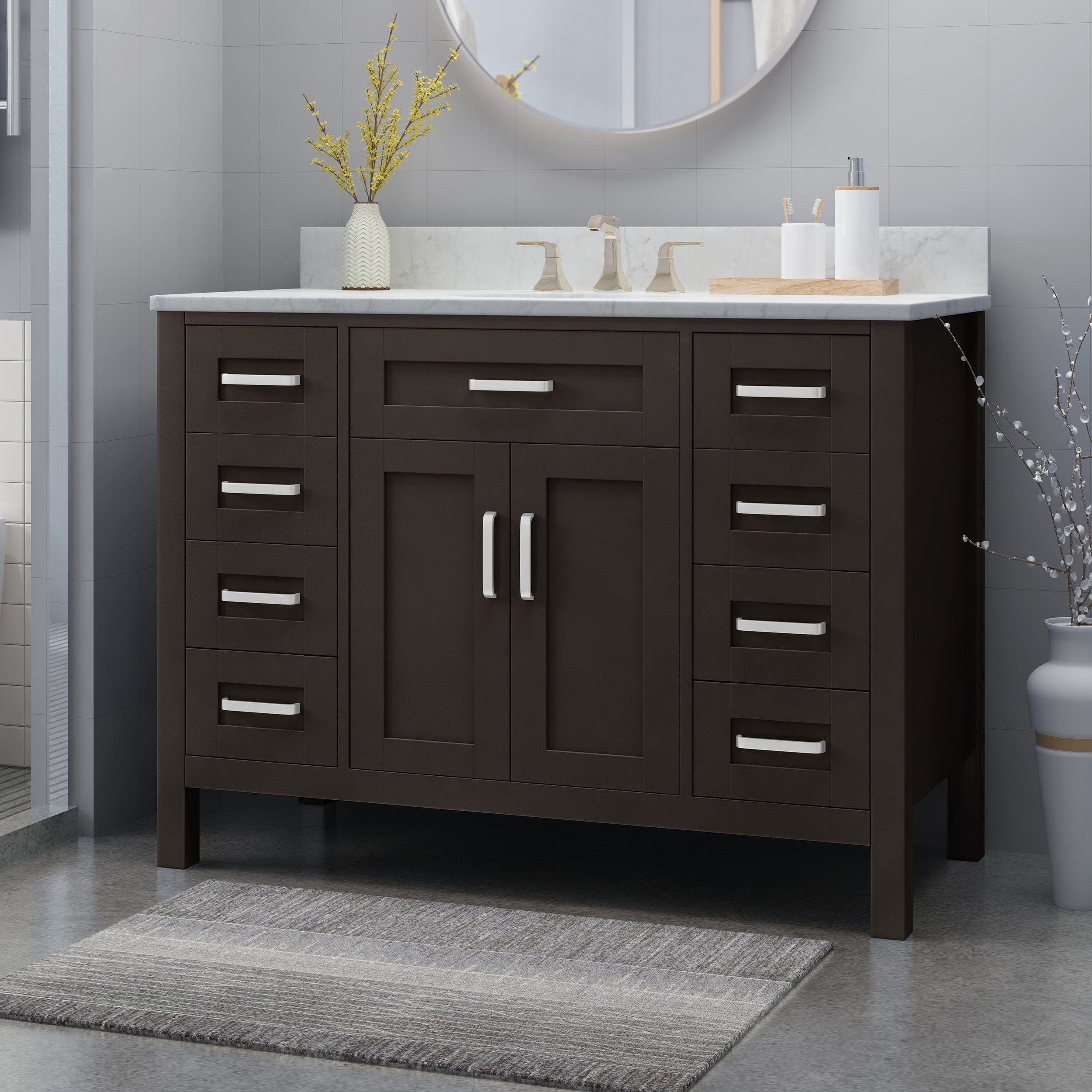Gray Bathroom Vanity Base Styles

A gray bathroom vanity base can be a versatile and stylish addition to any bathroom, offering a range of design options to suit various preferences and aesthetics. From sleek and modern to rustic and farmhouse, there’s a gray vanity base style to complement every bathroom decor.
Modern Gray Bathroom Vanity Bases
Modern gray bathroom vanity bases often feature clean lines, minimalist designs, and geometric shapes. They are typically characterized by their simplicity and functionality.
- Materials: Modern vanity bases are often crafted from materials like lacquered wood, high-gloss acrylic, or stainless steel. These materials contribute to the sleek and contemporary look.
- Finishes: Common finishes include matte gray, charcoal gray, or even a subtle metallic gray to enhance the modern aesthetic.
- Design Features: Modern vanities often incorporate features like floating designs, open shelving, and integrated lighting to enhance the minimalist aesthetic.
Traditional Gray Bathroom Vanity Bases
Traditional gray bathroom vanity bases exude a sense of timeless elegance and sophistication. They often feature intricate details, ornate carvings, and classic silhouettes.
- Materials: Traditional vanities are typically made from solid wood, such as oak, maple, or cherry, which are known for their durability and rich grain patterns.
- Finishes: Traditional vanities often feature a warm gray stain or a distressed finish to enhance their vintage appeal.
- Design Features: Distinguishing features include raised panels, fluted legs, and decorative hardware that adds a touch of classic charm.
Farmhouse Gray Bathroom Vanity Bases
Farmhouse gray bathroom vanity bases embody a rustic and cozy charm. They often feature a distressed or weathered look, incorporating natural elements and a touch of country charm.
- Materials: Farmhouse vanities are typically crafted from reclaimed wood, weathered barnwood, or distressed oak, adding to their rustic appeal.
- Finishes: The finishes often include a gray wash, a whitewash, or a distressed paint that enhances the rustic character.
- Design Features: Distinctive features include open shelves, X-shaped legs, and hardware with a vintage or antique look.
Industrial Gray Bathroom Vanity Bases
Industrial gray bathroom vanity bases embrace a raw and edgy aesthetic, inspired by industrial spaces and factories. They often feature exposed metal, concrete, and reclaimed wood elements.
- Materials: Industrial vanities are typically crafted from materials like metal, concrete, or reclaimed wood, reflecting their industrial roots.
- Finishes: Common finishes include a raw, unfinished metal look, a concrete gray finish, or a distressed wood finish.
- Design Features: Distinctive features include exposed pipes, metal accents, and a minimalist design with clean lines.
Contemporary Gray Bathroom Vanity Bases
Contemporary gray bathroom vanity bases blend modern and traditional elements, creating a sophisticated and stylish look. They often feature a mix of sleek lines, organic shapes, and natural materials.
- Materials: Contemporary vanities are often crafted from a combination of materials, such as wood, metal, or stone, creating a unique and visually appealing blend.
- Finishes: Contemporary vanities feature a range of finishes, including matte gray, charcoal gray, or a combination of gray and other neutral colors.
- Design Features: Distinctive features include a mix of straight lines and curves, open shelving, and unique hardware that adds a touch of personality.
Comparison of Gray Bathroom Vanity Base Styles
| Style | Materials | Finishes | Design Features |
|---|---|---|---|
| Modern | Lacquered wood, high-gloss acrylic, stainless steel | Matte gray, charcoal gray, metallic gray | Clean lines, minimalist design, geometric shapes, floating designs, open shelving, integrated lighting |
| Traditional | Solid wood (oak, maple, cherry) | Warm gray stain, distressed finish | Intricate details, ornate carvings, classic silhouettes, raised panels, fluted legs, decorative hardware |
| Farmhouse | Reclaimed wood, weathered barnwood, distressed oak | Gray wash, whitewash, distressed paint | Open shelves, X-shaped legs, vintage or antique hardware |
| Industrial | Metal, concrete, reclaimed wood | Raw, unfinished metal look, concrete gray finish, distressed wood finish | Exposed pipes, metal accents, minimalist design with clean lines |
| Contemporary | Wood, metal, stone | Matte gray, charcoal gray, combination of gray and other neutral colors | Mix of straight lines and curves, open shelving, unique hardware |
Gray Bathroom Vanity Base Materials

Choosing the right material for your gray bathroom vanity base is crucial, as it will impact the durability, aesthetics, and overall feel of your bathroom. Each material has its unique advantages and disadvantages, influencing its suitability for your needs. This section explores the most popular materials used for gray bathroom vanity bases, outlining their characteristics and suitability for different bathroom settings.
Material Properties, Pros, and Cons
The choice of material for your gray bathroom vanity base depends on your budget, desired aesthetic, and functional requirements. Each material has its unique set of properties, advantages, and disadvantages. The following table provides a comprehensive overview of the most common materials used for gray bathroom vanity bases, highlighting their key features:
| Material | Properties | Pros | Cons |
|---|---|---|---|
| Wood | Natural, warm, versatile, can be stained or painted | Elegant, timeless appeal, customizable, durable with proper care | Expensive, susceptible to water damage, requires regular maintenance |
| Laminate | Durable, water-resistant, affordable, available in various colors and patterns | Cost-effective, easy to clean, wide range of styles | Less durable than wood, can be prone to scratches, may not have the same aesthetic appeal as natural materials |
| Marble | Natural stone, elegant, unique veining patterns, heat-resistant | Luxurious, timeless, durable, adds elegance to any bathroom | Expensive, porous, susceptible to staining, requires regular sealing |
| Granite | Natural stone, durable, resistant to scratches and heat, wide range of colors and patterns | Hard-wearing, low maintenance, heat-resistant, adds a luxurious touch | Expensive, porous, requires sealing, can be heavy |
| Concrete | Modern, durable, customizable, can be molded into various shapes | Unique, industrial aesthetic, customizable, cost-effective | Heavy, requires sealing, can be prone to cracking if not properly installed |
Gray Bathroom Vanity Base Design Considerations

Selecting a gray bathroom vanity base goes beyond simply choosing a color. It involves a thoughtful consideration of various factors that contribute to both the functionality and aesthetic appeal of your bathroom. The right gray bathroom vanity base will seamlessly blend with your existing decor, enhance the space, and provide practical storage solutions.
Size and Shape
The size and shape of the vanity base are crucial considerations. The vanity base should be proportionate to the bathroom’s size, leaving adequate space for movement. Consider the following:
- Small Bathrooms: A compact vanity base with a single sink is ideal for smaller bathrooms, maximizing floor space.
- Larger Bathrooms: A double vanity base offers ample counter space and storage for larger bathrooms, accommodating multiple users.
- Shape: Rectangular vanity bases are common, offering a classic and practical design. Curved or rounded vanity bases add a touch of elegance and can be used to create a unique focal point in the bathroom.
Sink Type
The sink type is closely linked to the vanity base and influences both functionality and aesthetics.
- Undermount Sinks: Seamlessly integrated into the countertop, undermount sinks offer a sleek and modern look. They are also easier to clean as there are no edges or rims for dirt to accumulate.
- Vessel Sinks: Sitting atop the countertop, vessel sinks add a touch of elegance and can be found in a variety of materials and styles. They offer a unique visual appeal but may require more counter space.
- Integrated Sinks: These sinks are built into the countertop, creating a streamlined and seamless look. They are particularly popular in modern bathroom designs.
Storage Options
Storage is a critical consideration, particularly in smaller bathrooms.
- Drawers: Drawers provide ample storage for toiletries, towels, and other bathroom essentials. They are easily accessible and allow for organized storage.
- Cabinets: Cabinets offer larger storage capacity and are ideal for storing bulky items such as towels, linens, or cleaning supplies.
- Open Shelves: Open shelves provide a decorative touch and allow for easy access to frequently used items. They can also be used to display decorative items.
Hardware
Hardware, such as knobs, pulls, and hinges, can significantly impact the overall style of the vanity base.
- Modern Hardware: Sleek and minimalist hardware, often made of chrome or brushed nickel, complements modern bathroom designs.
- Traditional Hardware: Ornate hardware, such as brass or bronze knobs, adds a touch of elegance and complements traditional bathroom styles.
- Industrial Hardware: Industrial hardware, often featuring black or bronze finishes, adds a rustic and edgy touch to the bathroom.
Complementary Style and Color Scheme
Selecting a gray bathroom vanity base that complements the overall style and color scheme is crucial for achieving a cohesive and harmonious look.
- Modern Bathrooms: A light gray vanity base with sleek, modern hardware can complement a modern bathroom design featuring clean lines and minimalist decor.
- Traditional Bathrooms: A dark gray vanity base with traditional hardware can complement a traditional bathroom design featuring ornate details and classic fixtures.
- Transitional Bathrooms: A medium gray vanity base with transitional hardware can bridge the gap between modern and traditional styles, creating a balanced and versatile look.
Design Considerations Checklist
To guide your selection process, consider the following design considerations:
- Bathroom Size and Layout: Determine the available space for the vanity base and ensure it is proportionate to the bathroom’s size.
- Storage Needs: Assess your storage requirements and choose a vanity base with adequate drawers, cabinets, or shelves.
- Sink Type: Consider the desired functionality and aesthetics of the sink, choosing from undermount, vessel, or integrated sinks.
- Hardware Style: Select hardware that complements the overall style of the bathroom and vanity base.
- Color Scheme: Choose a gray shade that complements the existing color scheme and creates a harmonious look.
- Budget: Set a realistic budget and explore different vanity base options within your price range.
A gray bathroom vanity base can offer a sleek and modern aesthetic, but if you’re looking for a touch of warmth and richness, consider a 42 inch espresso bathroom vanity. The dark wood tones will complement the gray beautifully, creating a balanced and inviting space.
You can even use the gray vanity base as a starting point to explore other colors and textures in your bathroom decor.
A gray bathroom vanity base can be a timeless and elegant addition to any bathroom, providing a neutral backdrop for pops of color and texture. To enhance the functionality and visual appeal, consider incorporating a bathroom mirror with shelves behind above the vanity.
This creates a streamlined look while offering convenient storage for toiletries and decorative items, complementing the sleekness of the gray vanity base.
